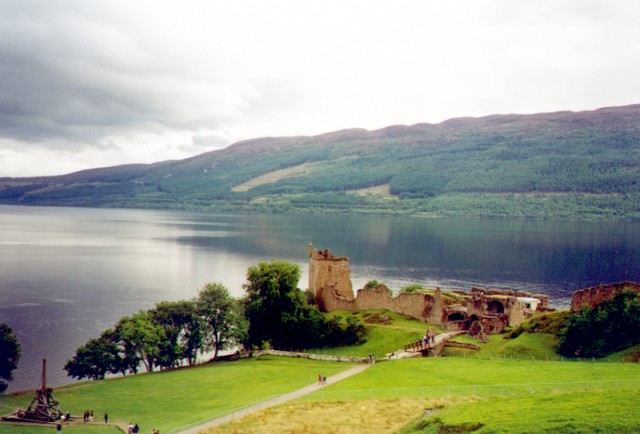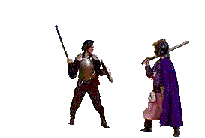

Urquhart Castle, near Inverness, Scotland, with siege engine being tested. Photograph © Graziella Umbro from PhotoImpact Users Photo Gallery, used by site permission.
HOW We Do What We Do
The Types of Activities in Which We Engage, including Combat, Feasts, Crafts, and Sundry Other Activities
Combat Most Chivalrous
The Society for Creative Anachronism began with a group who decided to dress up like knights in armor and try some fighting, and that's been the main attraction for many - but by no means all - members since. It's also the most popular of our activities when we demonstrate at the events of other groups.
Granted, Europe in the Middle Ages and Renaissance tended to be a bit cooler than Meridies in the summer. Carpet, foam, and plastic may occasionally replace some of the metal plate many people expect for armor with some fighters - but then, we are Creative Anachronists! Our fighters must make or buy their own armor, learn the rules of combat, fight with honor and acknowledge fair blows against them, and show courtesy and chivalry at all times. Safety is a primary concern, and restrictions on age and certain parts of armor is strict.
 |
Times are announced at the regular monthly meetings. Usual fighter practice & related activities on Sunday afternoons at Creekmore Park in Fort Smith, weather and other events permitting. Fighting in the Kingdom of Meridies is classed as "heavy" and "light". Heavy weapons are primarily made of rattan to simulate the weight and feel of broadswords, axes, maces, etc., and metal and leather armor is required. Our current Marshal will train fighters 18 years or older and help them accumulate armor and weapons. Light weapons, also called rapier or fencing, requires leather or triggercloth protection against schlagers (which are less breakable than actual rapiers). Rapier requires a different type of training. Smythkepe has the largest rapier fighter contingent in the Kingdom of Meredies. Our Rapier Marshal is Lord Regne' du Lyon and we currently have three Rapier Marshals In Training. |
Another areas of combat include archery (both combat and competition), siege engines (both combat and competition, and the various throwing forms: knives, axes, and in Smythkepe - Anvils!
Feasts, Food, Vintners and Brewers
It was not unusual during the Middle Ages for royal courts and other nobility to travel throughout their realm, descending - much like a swarm of voracious, well-garbed locusts - upon a local noble or administrator and honoring the region with their presence -- and appetites. Full formal feasts for such occasions and for various holidays could last literally for days, complete with course after course, storytelling, songs, dancing, toasts, and other activities to allow time for digesting.
In the Current Middle Ages, we don't go to quite such extremes, but we do honor our chefs, often called "Feastocrats", and encourage the arts - or are they sciences - of cooking, brewing and vinting. Our feasts accompany our events, and often can become quite detailed in an attempt to simulate the food and style of feasts during the Middle Ages and Renaissance. Ingredients are usually posted for the benefit of those with allergies.
Crafts, Better Known as Arts and Sciences
"If it breaks when you hit it, it's an art. If it doesn't, it's a science."
Well, that's the standard used by some in the Society. The Arts and Sciences are so important that they have their own Minister. The performing arts include storytelling, song and music, and drama. The crafts cover anything that might have been done in period, and range from replica buildings and woodworking, to dyeing your own wool and all the textile arts, to calligraphy and illumination, to making armor and weapons, to... well, just about anything that catches the historical interest. This is often seen at our various demonstrations, depending on the specialities of those attending.
Home Page Where Page Who Page What Page Links Page
Last revision: September 29, 2003
Copyright © 2003 by Shire of Smythkepe